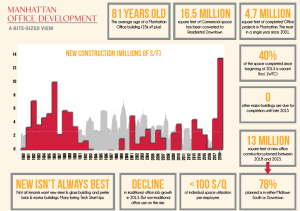You’ll hear arguments on both sides about whether New York City (and specifically Manhattan) needs any of the new office product that is now rising across Midtown South and Downtown. Let me lay down some facts and you can decide for yourself.
 The average age of an office building (25,000 square feet and greater) in Manhattan is 81 years. Yes, that does include recently completed properties such as 51 Astor Place and 4 World Trade Center
The average age of an office building (25,000 square feet and greater) in Manhattan is 81 years. Yes, that does include recently completed properties such as 51 Astor Place and 4 World Trade Center
- Buildings across the age spectrum continue to be adapted to residential use, especially downtown, where approximately 16.5 million square feet have been converted since 1995
- Completed office projects in Manhattan totaled 4.7 million square feet in 2013 – the most in one year since 2001 – though that is just 1.0% of the total inventory in the borough
- If 1 World Trade Center is thrown into the mix (its completion date is due this first quarter) then 40% of the space built since the beginning of 2013 is vacant
- No other major buildings are due for completion until late 2015, when 1045 Avenue of the Americas (aka 7 Bryant Park) along with 10 Hudson Yards should come on-line, with the latter 1.7-million-square-foot tower already close to being completely pre-leased/pre-sold
- Next up on the list will be 3 World Trade Center in 2017, followed by 30 Hudson Yards and, quite possibly, an almost brand new 425 Park Avenue
- After 2018, things get a bit foggy, though there is the potential in the following five years for approximately 10 million square feet of new office construction, with about 78% of that either in Midtown South or Downtown Manhattan
- Densification is most definitely happening across all industries – in some cases, “individual space utilization”, aka “benching”, is less than 100 square feet per person, though, at the same time, these companies are creating more collaborative space
- Traditional office job growth did decline rather sharply in Manhattan in 2013, though non-traditional sectors such as health and education have picked up the pace in taking up space in office buildings
- Not all tenants are suited to the larger floor plates and/or price of the new product and prefer the brick-and-mortar to the steel-and-glass, thus older buildings–especially those with tech upgrades–won’t lie fallow
So there you have them–10 bullet points to ponder. This is arguably the tip of the iceberg when delving into the topic of new construction’s impact. I’d welcome hearing the reader comments from all of you real estate wizards out there. Feel free to shoot me an email!


